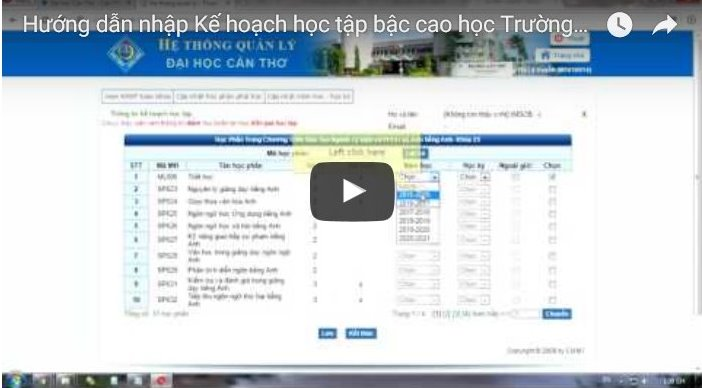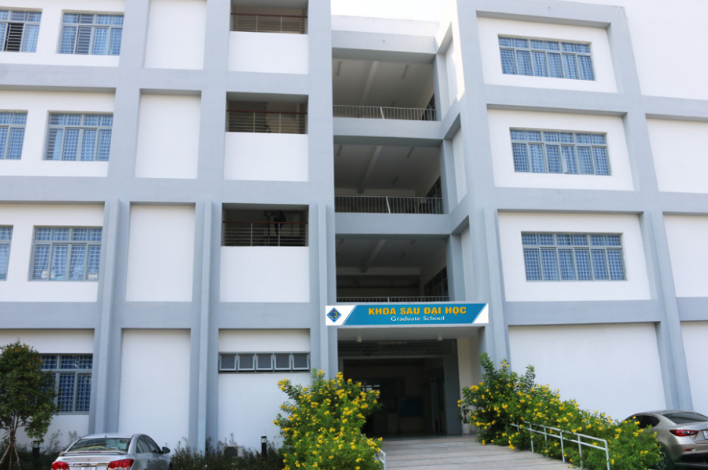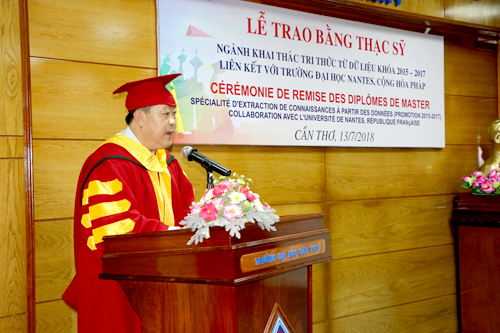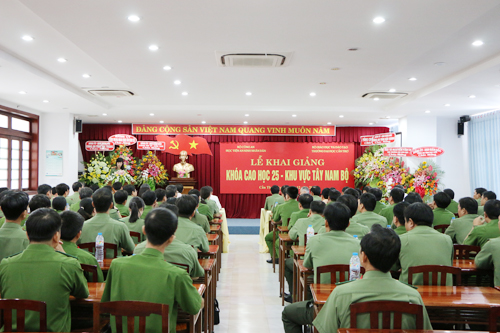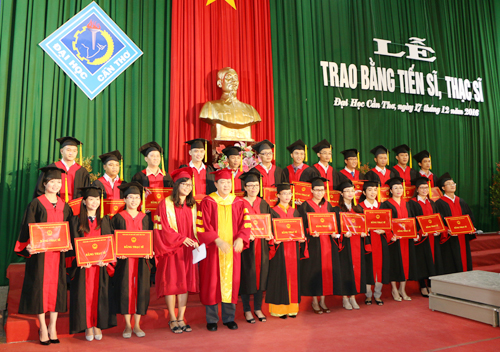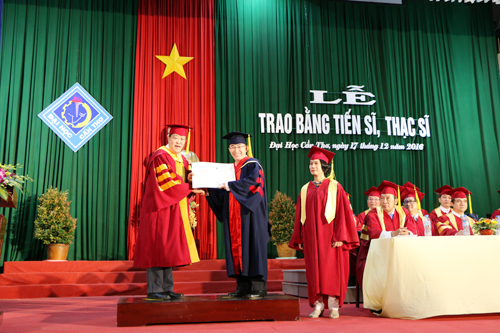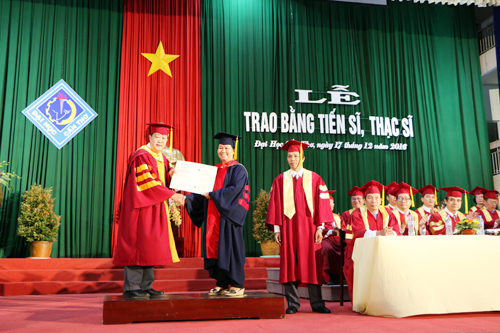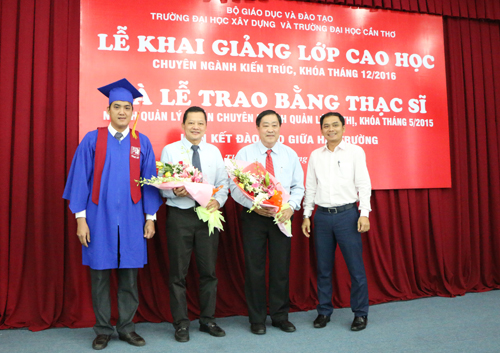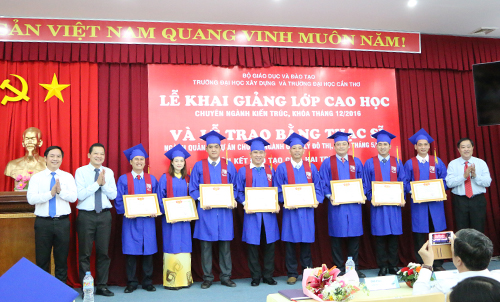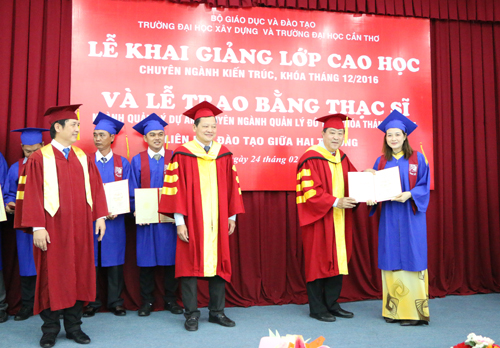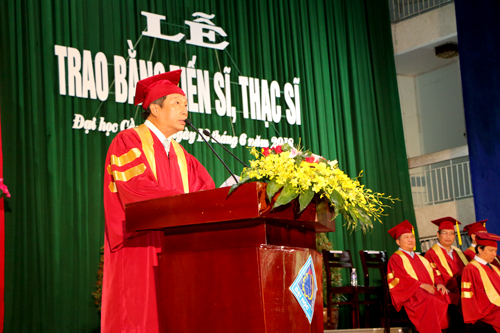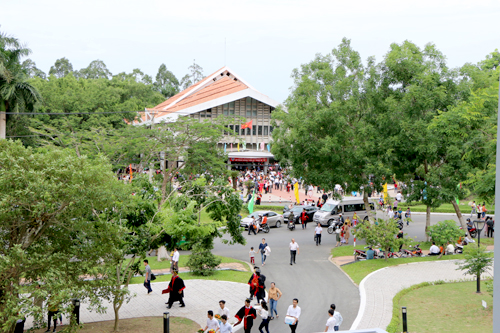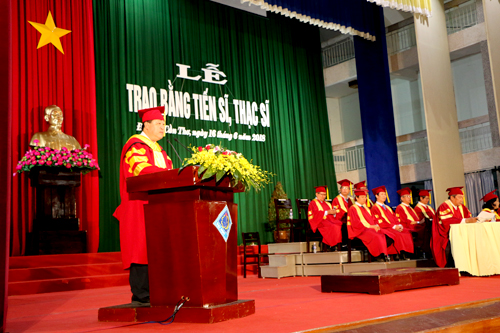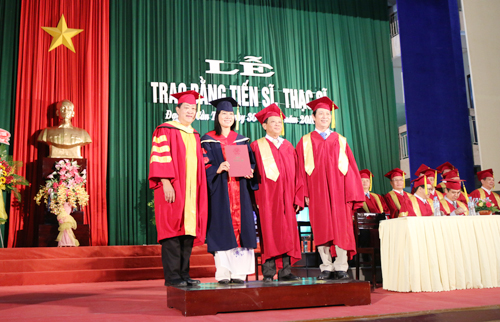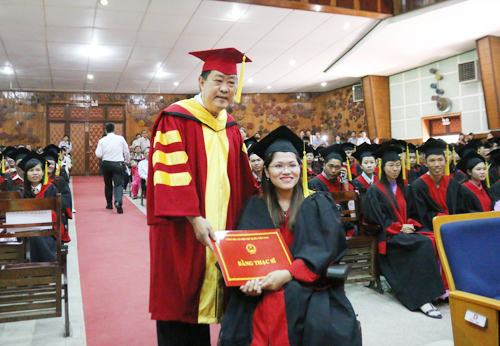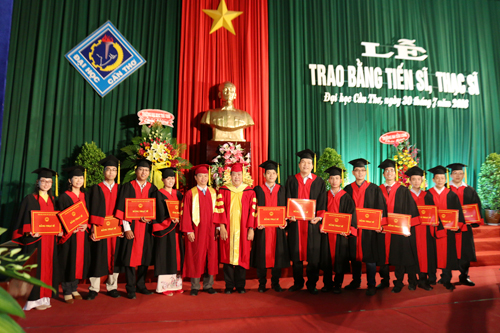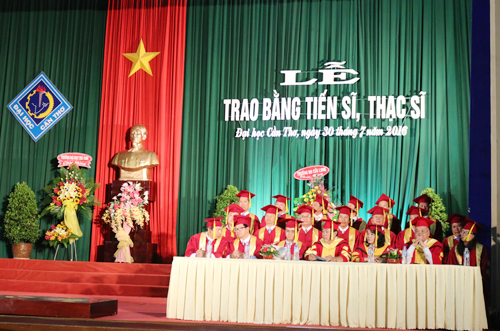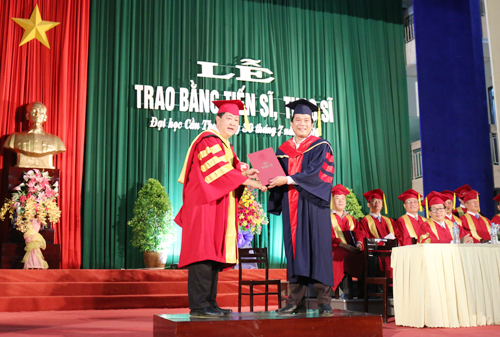
Tên đề tài: “Giải pháp nâng cao hiệu quả sản xuất mô hình luân canh lúa – mè tại đồng bằng sông Cửu Long”
Tác giả: Hồ Nhật Mai Trâm, Khóa: 2017
Ngành: Kinh tế nông nghiệp; Mã số: 62620115.
Người hướng dẫn chính: PGS.TS. Nguyễn Hữu Đặng - Trường Đại học Cần Thơ
Người hướng dẫn phụ: TS. Huỳnh Minh Tuấn – UBND tỉnh Đồng Tháp
- Tóm tắt nội dung luận án
Luận án ước lượng hiệu quả sản xuất cũng như phân tích các yếu tố ảnh hưởng đến hiệu quả sản xuất của các nông hộ canh tác theo mô hình luân canh lúa - mè tại đồng bằng sông Cửu Long. Luận án sử dụng bộ số liệu được khảo sát từ 191 nông hộ sản xuất theo mô hình luân canh lúa – mè thông qua bảng hỏi được soạn sẵn. Luận án đã áp dụng phương pháp phân tích chi phí – lợi nhuận (CRA) và phân tích biên ngẫu nhiên (SFA) tiếp cận theo định hướng đầu ra để ước lượng hiệu quả sản xuất của mô hình luân canh lúa – mè tại đồng bằng sông Cửu Long. Các yếu tố được xác định để ước lượng hiệu quả sản xuất gồm lao động, giống, phân bón, thuốc nông dược, diện tích gieo trồng. Bên cạnh đó, các yếu tố ảnh hưởng đến hiệu quả sản xuất của các nông hộ canh tác theo mô hình luân canh lúa - mè tại đồng bằng sông Cửu Long được xác định để phân tích gồm tuổi, trình độ học vấn, kinh nghiệm sản xuất của chủ hộ, tham gia tập huấn kỹ thuật trong sản xuất, thu nhập phi nông nghiệp, nguồn vốn sử dụng sản xuất, độ màu mỡ của đất sản xuất, mùa vụ sản xuất và hợp tác liên kết phát triển sản xuất. Qua đó, luận án đã đề xuất các giải pháp nhằm nâng cao hiệu quả sản xuất mô hình canh tác này.
Từ khóa: Giải pháp, hiệu quả sản xuất, luân canh, lúa, mè.
- Những kết quả mới của luận án
Thứ nhất: Kết quả nghiên cứu cho thấy nhóm các nông hộ canh tác theo mô hình luân canh lúa – mè đạt được mức hiệu quả tài chính cao hơn so với nhóm các nông hộ canh tác theo mô hình chuyên canh 3 vụ lúa. Sự khác biệt về hiệu quả tài chính giữa hai mô hình canh tác này được kiểm định và cho thấy có ý nghĩa ở mức 1%.
Thứ hai: Thông qua hàm sản xuất biên ngẫu nhiên dạng Cobb-Douglas, hiệu quả kỹ thuật vụ mè và các vụ lúa của các nông hộ canh tác theo mô hình luân canh lúa - mè đã được ước lượng. Kết quả phân tích cho thấy, mức hiệu quả kỹ thuật trung bình của các nông hộ đạt được ở vụ mè khoảng 82,22% và ở các vụ lúa là 80,05%. Mức hiệu quả kỹ thuật trung bình của các vụ sản xuất trong mô hình luân canh lúa – mè tại đồng bằng sông Cửu Long đạt mức khá cao. Ngoài ra, sự phân phối các mức hiệu quả kỹ thuật trong sản xuất lúa và mè của các nông hộ sản xuất theo mô hình luân canh lúa – mè tại đồng bằng sông Cửu Long đã phản ánh được lợi ích và tiềm năng của mô hình sản xuất này.
Thứ ba: Hiệu quả kinh tế của các nông hộ canh tác theo mô hình luân canh lúa - mè đã được ước lượng thông qua hàm lợi nhuận biên ngẫu nhiên dạng Translog bằng phương pháp ước lượng 1 bước (single–stage estimation). Kết quả phân tích cho thấy, mức hiệu quả kinh tế trung bình của các nông hộ đạt được khi sản xuất theo mô hình này là khoảng 68,26%. Bên cạnh đó, kết quả tại nghiên cứu này phát hiện có sự chênh lệch khá lớn về mức hiệu quả kinh tế giữa hộ đạt thấp nhất và hộ đạt cao nhất. Điều này cho thấy có sự chênh lệnh rất đáng kể về trình độ kỹ thuật sản xuất, khả năng lựa chọn đầu vào tối ưu tương ứng với giá cả trong sản xuất và các yếu tố về đặc điểm kinh tế - xã hội giữa các nông hộ. Qua đó cho thấy tiềm năng để cải thiện hiệu quả kinh tế, gia tăng lợi nhuận của các nông hộ là rất lớn nếu cải thiện được hiệu quả kỹ thuật và hiệu quả phân bổ của các nông hộ.
Thứ tư: Kết quả tại nghiên cứu này ước lượng được năng suất trung bình bị thất thoát do kém hiệu quả kỹ thuật ở vụ lúa ĐX khoảng 1.278,24 kg/ha/vụ, ở vụ lúa TĐ khoảng 2.005,72 kg/ha/vụ và ở vụ mè khoảng 197,05 kg/ha/vụ. Lợi nhuận trung bình bị thất thoát do kém hiệu quả kinh tế ở vụ lúa ĐX, vụ lúa TĐ và vụ mè theo kết quả xử lý số liệu điều tra trực tiếp nông hộ tại đồng bằng sông Cửu Long năm 2022 lần lượt là 6,61 triệu đồng/ha/vụ, 10,92 triệu đồng/ha/vụ và 12,36 triệu đồng/ha/vụ.
Thứ năm: Dựa trên kết quả nghiên cứu, luận án đã đề xuất các giải pháp về tổ chức sản xuất, nâng cao trình độ học vấn và năng lực tổ chức sản xuất cho nông dân, tăng cường nghiên cứu phục tráng và phát triển giống mè địa phương, đẩy mạnh ứng dụng cơ giới hóa và nâng cao hiệu quả sử dụng lao động, cải thiện chất lượng công tác đào tạo và huấn luyện của hệ thống khuyến nông, đẩy mạnh tín dụng phục vụ phát triển nông nghiệp và phát triển kinh tế tập thể để góp phần nâng cao hiệu quả sản xuất mô hình luân canh lúa – mè tại đồng bằng sông Cửu Long đối với các nông hộ sản xuất và đối với các nhà quản lý, xây dựng chính sách.
- Các ứng dụng/khả năng ứng dụng trong thực tiễn, các vấn đề cần tiếp tục nghiên cứu
Về mặt khoa học:
Thứ nhất: Luận án đã góp phần bổ sung vào các khoảng trống trong nghiên cứu về mặt phương pháp tiếp cận so với các công trình đã thực hiện nghiên cứu hiệu quả sản xuất mô hình canh tác luân canh lúa – mè khi thực hiện ước lượng hiệu quả sản xuất cho cả mô hình canh tác này tại đồng bằng sông Cửu Long thông qua phương pháp tham số (SFA) trên các dạng mô hình ước lượng khác nhau (dạng Cobb-Douglas và Translog) và chọn lựa mô hình phù hợp nhất. Lý thuyết về phương pháp tham số (SFA) được hệ thống hóa đầy đủ trong luận án nhằm ước lượng hiệu quả kỹ thuật và hiệu quả kinh tế của các nông hộ trồng lúa và mè theo mô hình sản xuất luân canh lúa – mè tại đồng bằng sông Cửu Long. Trước đó, một số ít công trình nghiên cứu về hiệu quả sản xuất mô hình luân canh lúa - mè đã thực hiện trên phạm vi quy mô nhỏ theo địa phương, sử dụng phương pháp phi tham số (DEA) để ước lượng hiệu quả kỹ thuật, hiệu quả kinh tế trong sản xuất của mô hình canh tác. Do đó, chưa ước lượng được các nhiễu thống kê và các sai số đo lường, không kiểm định được giả thuyết, và khi bổ sung thêm một mẫu quan sát thì có thể làm ảnh hưởng đến kết quả đo lường hiệu quả.
Thứ hai: Các nghiên cứu về hiệu quả sản xuất của mô hình luân canh lúa - mè trên phạm vi toàn vùng tại đồng bằng sông Cửu Long nói riêng và cả nước nói chung còn rất hạn chế. Trước đó, phần lớn các nghiên cứu thực hiện ước lượng hiệu quả sản xuất bằng cách đo lường hiệu quả kỹ thuật và hiệu quả kinh tế của từng sản phẩm đầu ra trong từng vụ sản xuất, chưa thực hiện ước lượng hiệu quả sản xuất theo mô hình canh tác, cụ thể là mô hình canh tác luân canh lúa - mè - lúa trên phạm vi toàn vùng đồng bằng sông Cửu Long. Do đó, thông qua nghiên cứu này, luận án đã góp phần bổ sung cơ sở lý luận về khung nghiên cứu liên quan đến hiệu quả sản xuất của mô hình canh tác luân canh lúa – mè tại đồng bằng sông Cửu Long nói riêng và nghiên cứu hiệu quả sản xuất của mô hình canh tác luân canh lúa - màu nói chung.
Thứ ba: Luận án đã áp dụng phương pháp phân tích chi phí – lợi nhuận (CRA) để xác định hiệu quả tài chính của mô hình sản xuất luân canh lúa – mè và mô hình sản xuất lúa truyền thông chuyên canh 3 vụ lúa tại đồng bằng sông Cửu Long. Đồng thời, luận án đã thực hiện đối sánh hiệu quả tài chính của hai mô hình sản xuất trên mà các nghiên cứu trước đây chưa đề cập đến.
Thứ tư: Luận án đã có nghiên cứu sự nối kết giữa đầu vào và đầu ra trong phân tích hiệu quả kỹ thuật (hàm sản xuất biên ngẫu nhiên) và hiệu quả kinh tế (hàm lợi nhuận biên ngẫu nhiên) mô hình sản xuất luân canh lúa – mè. Với những khám phá mới từ kết quả nghiên cứu của đề tài này sẽ là cơ sở khoa học để các nghiên cứu tiếp theo có thể kế thừa hoặc tiếp tục phát triển mở ra một hướng nghiên cứu mới.
Thứ năm: Luận án đã kết hợp các phương pháp phân tích định tính và định lượng một cách hợp lý để phân tích các vấn đề nghiên cứu đặt ra một cách hiệu quả. Từ đó đã phát hiện được các yếu tố chính ảnh hưởng đến hiệu quả sản xuất của mô hình canh tác luân canh lúa – mè.
Thứ sáu: Các giải pháp nâng cao hiệu quả sản xuất mô hình luân canh lúa – mè tại đồng bằng sông Cửu Long đã được đề xuất dựa trên cơ sở các bằng chứng khoa học từ kết quả nghiên cứu.
Về mặt thực tiễn:
Thứ nhất: Luận án đã có đóng góp đáng kể về mặt thực tiễn khi nghiên cứu các vấn đề liên quan tới hiệu quả tài chính của mô hình luân canh lúa – mè ở đồng bằng sông Cửu Long, thực hiện đối sánh với hiệu quả tài chính của mô hình canh tác lúa truyền thông (canh tác chuyên canh 3 vụ lúa). Có thể thấy, để thực hiện sứ mệnh “an ninh lương thực”, trong đó chủ chốt là lúa gạo, đồng bằng sông Cửu Long đã ưu tiên thâm canh, tăng vụ lúa trong nhiều năm. Tuy nhiên, theo VCCI & Fulbright (2023) cần có tư duy mới về an ninh lương thực vì đồng bằng sông Cửu Long là vùng sản xuất lúa lớn nhất cả nước và đưa Việt Nam trở thành quốc gia xuất khẩu gạo hàng đầu thế giới “nhưng lại không giúp đồng bằng sông Cửu Long trở nên thịnh vượng”. Do đó, kết quả phân tích và đối sánh hiệu quả tài chính của mô hình luân canh lúa – mè và mô hình canh tác lúa truyền thông tại đồng bằng sông Cửu Long là cơ sở để các nông hộ cân nhắc, ra quyết định chọn mô hình canh tác phù hợp; là cơ sở để các trung tâm khuyến nông tham khảo trong công tác tư vấn chọn mô hình canh tác, chuyển đổi mô hình canh tác tại địa phương.
Thứ hai: Luận án đã phân tích được thực trạng tình hình sản xuất cũng như đánh giá được hiệu quả sản xuất theo mô hình luân canh lúa – mè tại đồng bằng sông Cửu Long một cách có hệ thống về kỹ thuật, các yếu tố đầu vào và đầu ra của mô hình sản xuất luân canh lúa – mè theo phạm vi quy mô các nông hộ ở địa bàn nghiên cứu. Kết quả nghiên cứu đã xác định và đánh giá được hiệu quả sản xuất của mô hình luân canh lúa – mè tại đồng bằng sông Cửu Long đang chịu ảnh hưởng bởi các yếu tố nào, chiều hướng cũng như mức độ ảnh hưởng.
Thứ ba: Luận án không chỉ cung cấp các cơ sở khoa học mà còn cung cấp các bằng chứng thực nghiệm về các yếu tố ảnh hưởng đến hiệu quả sản xuất của lúa và mè trong mô hình luân canh lúa – mè. Từ đó, giúp nông hộ và các nhà quản lý lựa chọn các giải pháp phù hợp để nâng cao hiệu quả sản xuất và là cơ sở để nâng cao giá trị gia tăng, thu nhập của nông hộ trồng lúa – mè tại đồng bằng sông Cửu Long.
Thứ tư: Các giải pháp nâng cao hiệu quả sản xuất mô hình luân canh lúa – mè được đề xuất thông qua công trình nghiên cứu này có giá trị ứng dụng cao, liên quan đến các tác nhân tham gia trong quá trình sản xuất và tiêu thụ sản phẩm của mô hình sản xuất luân canh lúa - mè, góp phần thúc đẩy việc chuyển đổi cơ cấu cây trồng tại đồng bằng sông Cửu Long theo hướng phát triển bền vững.
Thesis title: “Solutions to improve production efficiency of rice-sesame rotation model in the Mekong Delta”
- Major: Agricultural Economics Code: 9620115
- Full name of PhD student: Ho Nhat Mai Tram Training period: 2017 - 2021
- Supervisor: PhD. Nguyen Huu Dang - Can Tho University
- Sub-Supervisor:Dr. Huynh Minh Tuan - Dong Thap Provincial People's Committee
- Training institution: Can Tho University
- Dissertation summary
The thesis aims to estimate the production efficiency and analyze the factors influencing in the production efficiency of the rice-sesame rotation model adopted by farmers in the Mekong Delta. Based on primary data collected from 191 farming households following the crop rotation model of 2 rice crops and 1 sesame crop by direct questionnaire survey. The thesis applied the cost-benefit analysis method and the stochastic frontier analysis method with an output-oriented approach to estimate the production efficiency of the rice - sesame rotation model in the Mekong Delta. The factors identified to estimate production efficiency are labor, seed, fertilizer, agrochemical, planted area. Furthermore, the factors influencing it in the production efficiency of the rice-sesame rotation model adopted by farmers in the Mekong Delta identified for analysis including: age, education attainment, experience, technical training, non-agricultural income, capital used for production, soil fertility, farming season and producing cooperative groups. Thereby, the thesis has proposed a number of solutions to improve the production efficiency of this farming model.
Keywords: solution, production efficiency, rotation model, rice, sesame.
- New results of the thesis
Firstly, the result of research showed that the financial efficiency of the group of farming households following the rice-sesame rotation model was higher than farming households following the specialized crop model of 3 rice crops. The difference of financial efficiency between these two farming models was assessed and its statistical significance is at the 1% level.
Secondly, the technical efficiency of sesame and rice crops of farming households following the rice - sesame rotation model was estimated by the stochastic frontier Cobb-Douglas production function. The analysis result showed that the average technical efficiency of sesame crop was 82.22% and the average level of technical efficiency of rice crops was 80.05%. The average technical efficiency in the rice - sesame rotation model in the Mekong Delta was quite high. Moreover, the distribution of the level of technical efficiency of farming households following the crop rotation model showed that the advantages and potential of this production model.
Thirdly, the economic efficiency of farming households following the rice - sesame rotation model was estimated by the stochastic frontier Translog profit function by single–stage estimation. The analysis results showed that the average economic efficiency of this model was about 68.26%. Besides that, the results of this study found that the economic efficiency of the highest achieving household was difference with the economic efficiency of the lowest achieving household pretty large. There were very significant differences in production technical levels, the ability to choose optimal inputs corresponding to production prices and socio-economic factors among farmers household. If the technical efficiency and allocative efficiency of farming households was improved, the potential to improve economic efficiency and increase the profits of farming households was huge.
Fourthly, the results of this study estimated that the loss of rice and sesame productivity by technical ineffectiveness was about 1,278.24 kg/ha in winter-spring rice crop, about 2,005.72 kg/ha in autumn-winter rice crop and about 197.05 kg/ha in sesame crop. The loss of the average profit by economic ineffectiveness according to the results of processing data from a direct survey of farmers in the Mekong Delta in 2022 was 6.61 million VND/ha in winter-spring rice crop, was 10.92 million VND/ha in autumn-winter rice crop and was 12.36 million VND/ha in sesame crop.
Fifthly, based on the research results, the thesis proposed solutions on production organization, improving the education level and production organization capacity for farmers, strengthening research on restoration and development of local sesame varieties, promoting the application of mechanization and improving labor efficiency, improving the quality of training and coaching of the agricultural extension system, promoting credit for agricultural development and collective economic development to contribute to improving the production efficiency of the rice-sesame rotation model in the Mekong Delta for farmers and for managers and policy makers.
- Practical applications/applicability, issues that need further research
Scientific aspect:
Firstly, the thesis has contributed to filling in the gaps in research in terms of approaches compared to works that have researched the production efficiency of the rice - sesame rotation farming model when implementing estimates. Quantifying production efficiency for this farming model in the Mekong Delta through the parametric method (SFA) on different types of estimation models (Cobb-Douglas and Translog forms) and choosing the appropriate model. The theory of parametric method (SFA) is fully systematized in the thesis to estimate the technical efficiency and economic efficiency of the rice-sesame rotation production model in the Mekong Delta. Previously, a few research projects on the production efficiency of the rice-sesame rotation model were conducted on a small local scale, using Data Envelopmnet Analysis method (DEA) to estimate the efficiency technical and economic efficiency of the farming model. Therefore, statistical noise and measurement errors cannot be estimated, the hypothesis cannot be tested, and adding an additional observation sample may affect the effectiveness measurement results.
Secondly, there is not much more research about the production efficiency of the rice - sesame rotation model on a regional scale in the Mekong Delta in particular and the country in general. Before that, most studies only estimated production efficiency by measuring the technical efficiency and economic efficiency of each output product for each production season, have not estimated production efficiency according to farming models, specifically the rice-sesame-rice rotation farming model in the entire Mekong Delta. Therefore, through this research, the thesis has contributed to supplementing the theoretical basis of the research framework related to the production efficiency of the rice - sesame rotation farming model in the Mekong Delta in particular and research the production efficiency of the rice-crop rotation farming model in general.
Thirdly, the thesis applied the cost-profit analysis method to identify the financial efficiency of the rice-sesame rotation production model and the specialized crop model of 3 rice crops in the Mekong Delta region. The thesis had also compared the financial efficiency of two model that previous studies have not mentioned.
Fourthly, the thesis researched the connection between input and output in Analysis technical efficiency (the stochastic frontier production function) and economic efficiency (the stochastic frontier profit function) of the rice-sesame rotation farming model. With new explorations from the research results will be a scientific basis for future research directions which can be adopted by many researchers or continued to develope new research.
Fifthly, the thesis reasonably combined both qualitative and quantitative analysis methods to effectively analyze the research issues. Since then, the main factors affecting the production efficiency of the rice-sesame rotation farming model have been discovered.
Sixthly, based on scientific evidence from research results, solutions to improve production efficiency of the rice-sesame rotation model in the Mekong Delta were proposed.
Practical aspect:
Firstly, the thesis has made a significant practical contribution when researching issues related to the financial efficiency of the rice - sesame rotation model in the Mekong Delta and comparing with the finance efficiency of traditional rice farming model (specialized cultivation of 3 rice crops). It seems that the Mekong Delta has prioritized intensive farming and increased rice crops for many years to carry out the mission of "food security", in which rice is the key. However, according to VCCI & Fulbright (2023), there is a need for new thinking on food security because the Mekong Delta is the largest rice producing region in the country and makes Vietnam become the world's leading rice exporter. However, there is not to help the Mekong Delta become prime. Therefore, the results of analyzing and comparing the financial efficiency of the rice-sesame rotation model and the traditional rice cultivation model in the Mekong Delta are the basis for farmers to consider and make decisions about choosing the suitable farming models; is the basis for agricultural extension centers to refer to in consulting on choosing farming models and converting farming models locally.
Secondly, the thesis analyzed the current production situation as well as evaluated the production efficiency of the rice - sesame rotation model in the Mekong Delta in a systematic way in terms of techniques and factors, inputs and outputs of the rice-sesame rotation production model according to the scale of farming households in the study area. The research results also identified and evaluated the production efficiency of the rice - sesame rotation model in the Mekong Delta, which factors are being influenced, the direction and level of influence.
Thirdly, the thesis not only provides scientific basis but also provides experimental evidence on factors affecting the production efficiency of rice and sesame in the rice-sesame rotation model. It helps farmers and managers choose appropriate solutions to improve production efficiency and is the scientific basis for increasing the added value and income of farmers in the Mekong Delta.
Fourthly, solutions to improve the production efficiency of the rice - sesame rotation model proposed through this research have high application value, related to the actors involved in the production process and consuming products of the rice - sesame rotation production model, contributing to promoting the transformation of crop structure in the Mekong Delta towards sustainable development.
- Xem chi tiết nội dung luận án
- Xem thông tin đăng tải tại Website Bộ giáo dục và Đào tạo. (Nhập tên NCS vào ô tìm kiếm)

